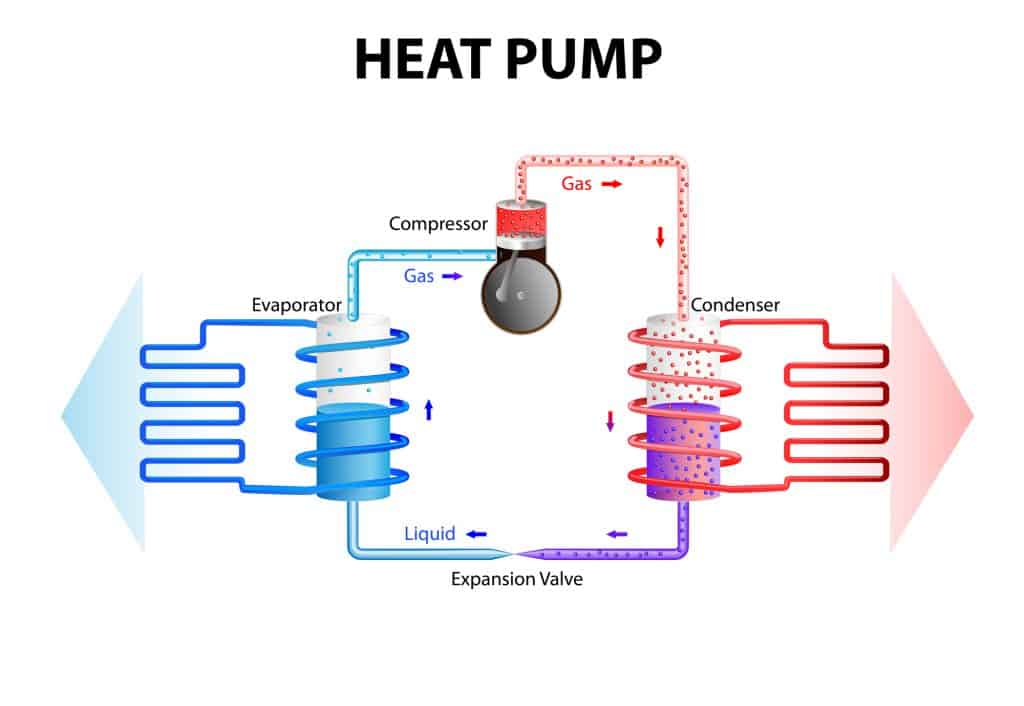The Nissan Leaf was the first mass-produced vehicle in the world that used a heat-pump system for cabin warming. Other electric cars have used electrical heaters, which while effective in providing heat are a huge drain on the car’s battery power. An alternative system had to be developed, and one soon came along — the heat pump.
In today’s blog, we’re looking at heat pumps specifically in Nissan cars, how they work, what benefits they bring and more. Let’s start by being clear on what the heat pump technology is and how it works.
What Is a Heat Pump? How Do They Benefit Electric Cars?

Many of us take the heating in our gasoline and diesel cars completely for granted. We flip the switch and heating comes into the car. Where does it come from? Typically, an internal combustion engine will extract heat from the engine’s cooling system to create that lovely warm cabin on a cold winter’s morning. It’s easy when the engine is running and the heat is just there all the time anyway. It’s just a matter of transferring it into the cabin where it can actually do some good.
Why are electric cars different, then? The main reason of course is that an EV does not have an internal combustion engine at the helm. No combustion engine means no heat and that means the heat has to be generated in a different way. The initial solution used by EV creators was a simple electric resistance heater not dissimilar to those used on a small scale at home. One big difference to home heaters was present though, which is that the heaters in EVs were running off the car’s battery power.
The heat pump is an ingenious system that flips the entire heating paradigm on its head and helps to save a huge amount of energy from the battery in the process. The heat pump uses the difference in temperature between a refrigerant and the air outside. Here’s a breakdown of how it works:
- First, the external capacitor absorbs heat from the atmosphere
- It compresses this heat into a higher-temperature heat
- Next, the cold air in the cabin is heated and hot air emerges from the ventilator grilles
- As it does it will decompress and start to go back to a low temperature
- This lower-temperature air is then released back out of the car via the lower vents and put back into the atmosphere

The main benefit of the heat pump to an electric car is the removal of strain on the battery. Resistance heat running from the battery (especially if the battery itself is cold) is a huge drain on power. The website caranddriver.com did a test on a Tesla Model 3, which in 2020 and the time of reporting was not yet using a heat pump. It got one in the 2021 model-year refresh.
The test by caranddriver.com found the shocking truth that running the conventional resistance heating at high levels cut range from 234 miles with the heating off down to 173 miles when the heating was set to high and also used in the seats. This is always more pronounced in winter cold. It’s also the reason Tesla is now pursuing the heat pump technology in more of its models, like the Model Y and brand-new 2021 Model 3.
Why Don’t All EVs Now Have Heat Pumps?
The Nissan Leaf started to use the heat pump technology back in 2013, so why in 8 years has it not become the industry standard on all EV models? There are a couple of reasons for this:
Cost
As things have stood over the past 8 years, adding a heat pump to the car is one way to add significant cost to the vehicle. It will cost at least several hundred dollars more. As the technology improves and becomes more mainstream, then costs should naturally come down, but cost is a big factor as to why many brands have been “late to the party.”
Battery Warming
The problem with heating systems were that you needed them at times when your battery was also suffering in the cold weather. In the meantime, many EV producers have come up with clever ways to precondition the battery while it is still connected to a home charging unit. This allows the battery to reach an optimum temperature before you start up, and it can do so without losing any power from the battery range. The driver can get into their car with full range, a warmer battery and therefore less impact even from their resistance heater.
For these two main reasons, companies have been somewhat slower in their uptake of heat pumps for EVs, but now the idea is catching on. Following the lead of the Nissan Leaf, other brands that use the heat pump include: Jaguar, BMW, Audi, Toyota and VW. Interconnected Korean giants Hyundai and Kia differ on their use, with the former not using it in their Kona Electric, but the latter using it in their Kia Niro EV.
How To Tell If A Leaf Has A Heat Pump System
The heat pump is part of Nissan’s “hybrid heater system,” which is not standard on every Nissan Leaf. In the current lineup, there are three trim levels where you can get the heat pump: the SV, the SL Plus and the SV Plus. It comes as standard on these three trims but is unavailable on other trims.
If you’re buying a new Nissan Leaf and you want to take advantage of the heat pump, then you should purchase one of the three trim levels that has one since it’s not even an option on the others.
If you are buying second-hand, there are usually ways to know if the Leaf has the heat pump – for example:
- If the pre-owned Nissan Leaf has the cold weather package installed, then the heat pump is there.
- Remember, though, that the pre-owned models must be from the 2013 model year or later to have a heat pump. So if the Leaf is older than the 2013 model, then it definitely won’t have a heat pump.
- A heat pump is basically an air conditoner that cools outside air, diverting the generated heat into the cabin. This requires extra hoses and valves. So if you look under the hood, a Leaf with a heat pump system will have more hoses and valves (for the heat pump system) than a standard AC-only Leaf which will only have a few hoses for the AC system.
What are the Pros and Cons of Heat Pumps?
Above we already mentioned that heat pumps can help to take strain of the EV battery, which is the primary advantage. Besides that, they come with the following benefits:
- In being less hungry for energy, the heat pump helps the Nissan Leaf to further boost its eco-friendly credentials.
- The heat pump can actually be used for both heating and cooling, making it a more encompassing system.
- The heat pump works at outdoor ambient temperatures as low as -20 degrees Celsius (-4 Fahrenheit).
- The maintenance requirements on a heat pump are actually quite low compared to a traditional a/c system
Cons of Nissan Leaf and other Heat Pumps
Having said all of that, it would be naïve to assume that it’s all good news. Here are some of the cons of a heat pump:
- Currently they are much more expensive than conventional systems and therefore contribute to making cars like the Nissan Leaf more expensive than they otherwise could be.
- While it may mitigate some range loss, especially in winter time when driving in the city, it won’t do anything to add to the range of an EV, which is another reason many brands aren’t rushing to install it as a standard feature.
Is it Possible to Retrofit a Nissan Leaf with a Heating Pump?

The main difference that sets apart the 2013-2017 Nissan Leaf models — the first to have the mass-produced heat pump technology — is that they contain a component called a reversing valve. This part proves crucial in whether or not the heating pump can be added. At the time, it was only present in the SV and SL trims, where the base S trims did not have it. The absence of the hybrid heating system means they are not eligible.
It’s the same story with the newest Nissan Leafs. The heat pump now comes as a standard feature on the three trims mentioned above, but not even as an optional one on the lower trims.
Conclusion: Is the Heat Pump Worth It?
At the end of the day, is the Nissan Leaf heat pump worth it? It would seem yes, it is. Though the heat pump hasn’t been responsible for any dramatic increase in the power or range of the Nissan Leaf, it has made the heating system far more efficient and helped to make the Nissan Leaf an even greener car than other competitors in the space.
It’s certainly worth asking and checking if a pre-owned Nissan Leaf you are looking to purchase has the heat pump option. This is especially true if you live in a geographical area with very cold winters.
10 comments
Well I’m a bit disappointed in that the teaser indicated there was an actual way to tell if you had a heat pump or not. I’ve heard if they have a full complement of heated seats that’s and indicator that you’ve got a heat pump. But who really knows.
Apologies, you’re right that it’s a bit of an unknown at times (annoyingly). Interesting point about a full complement of heated seats might indicate a heat pump though, that’s good to know.
There is an easy way to identify the heat pump.
It is essentially an air conditioner that is cooling the outside air and expelling heat into the cabin.
This is the reverse of normal air conditioning that cools the cabin and expels heat to the outside.
The plain air conditioner under the hood has just a few hoses going to it, like any other car’s air conditioner.
The heat pump air conditioner adds several hoses and valves for reversing the follow of the refrigerant.
Thanks for adding this Clarence, that’s really useful to know.
If I looked under the hood (bonnet here in the UK) of my Leaf you’ve not provided any “reference points” to allow me to decide whether I have a heat pump or just a simple aircon installed. Much better would be to have two photos in the article – one *with* and one *without* a heat pump – clearly indicating what the differences are.
(Clarence’s answer doesn’t make the situation any clearer – there’s no hose count or any other specifics to look out for, simply saying “there’s more hoses” is completely unhelpful unless you know how many hoses there are on the simple aircon unit !!)
The section on “Is it Possible to Retrofit a Nissan Leaf with a Heating Pump?” is weird as there’s no actual answer, just an explanation of the differences (= the reversing valve), with no details as to whether anyone has tried it, whether it might be worth the expense, etc, etc.
Otherwise it a great article 🙂
When I read the glaring inaccuracy in your first paragraph it casts doubt on the validity of the rest of your article, however well it may be written.
It is now very rare to use the exhaust system of a car to heat the interior.
The obvious danger being a leaking exhaust sending carbon monoxide through to the vehicle cabin.
The most commonly used system on a motor vehicle uses heat from the vehicles cooling system, obviously generated by the temperatures an IC engine runs at.
The downside of this is that the IC engine takes time to get up to a useful temperature so with short runs it is not so efficient.
Whoops you’re quite right, apologies for the basic mistake. Yes that’s what I originally ‘intended’ to write (i.e. that the hot ICE engine is what indirectly heats up the cabin), but I missed out that it’s the heat extracted from the cooling system that is where the cabin heat actually comes from. I’ve tweaked that now – thanks for the insightful comment, Gerard.
Would using my vin number to access my car options be a way to determine if I have a heat pump or not?
I’m not 100% sure sorry – I don’t think that a lot of VIN checkers give that detailed information, but I haven’t got a Leaf so I can’t say for sure. I’ll leave your comment here in-case a current Leaf owner can confirm either way.
I must say that this is stupidiest article what I have ever read of this.
1) you can run heat pump from wall power so battery heating argument is just pure nonsense
2) heatpumps it self are not so expensieve. All cars have already them. AC versus heatpump is just one 4 way valve more. Cost difference at factory is less than 200eur when counting all extra parts.
3) yes it wont add range BUT it will mitigate range loss at winter. So basically it add range at winter.